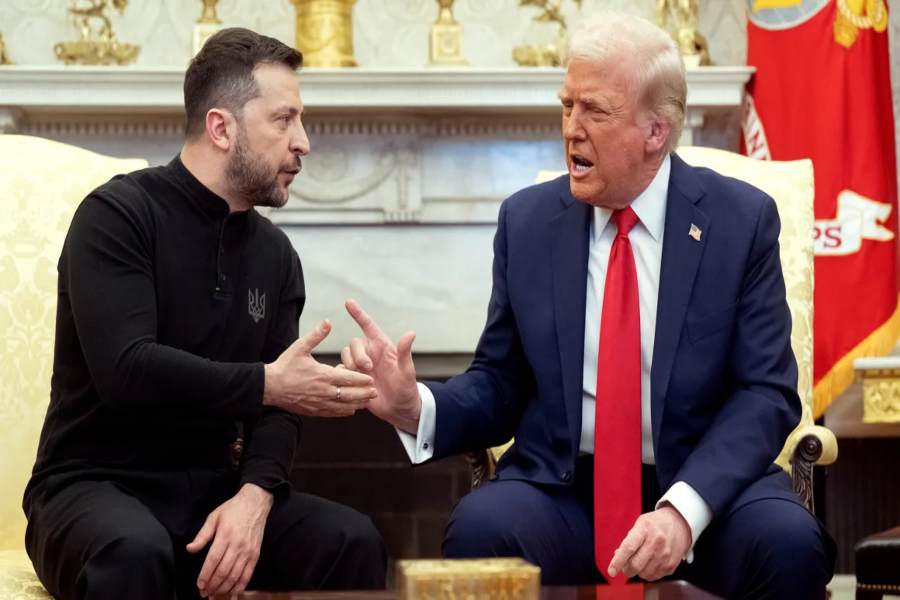Ukrainian President Volodymyr Zelensky is renewing his demand for firm security guarantees from the United States and Europe as the war in Ukraine drags on with no clear end in sight. His plea comes amid growing concern in Kyiv that any ceasefire agreement with Russia would be meaningless without a robust system to prevent future aggression.
During a heated meeting at the White House last week, Zelensky clashed with former U.S. President Donald Trump and Vice President JD Vance over the need for concrete guarantees. Zelensky questioned how Ukraine could trust Russian President Vladimir Putin to honor any deal and not launch another invasion a year or two later. Trump, however, appeared dismissive. “Security is so easy, that’s about 2% of the problem,” he said, minimizing Zelensky’s concerns and offering vague solutions, including an offhand remark about U.S. companies mining in Ukraine acting as a deterrent to Russian aggression. Hours later, Trump announced a pause in U.S. military aid to Ukraine, signaling a shift in American support.
While Trump downplays the issue, other U.S. officials have taken a more measured approach. Secretary of State Marco Rubio stated that Ukraine requires a credible deterrent, suggesting that European nations could play a more significant role. However, Defense Secretary Pete Hegseth and National Security Adviser Mike Waltz made clear that American troops would not be involved, and European forces would not be covered under NATO’s collective defense principle. This has left Ukraine in a vulnerable position—caught between fading U.S. support and an unprepared Europe.
Over the weekend, European leaders gathered in London to discuss Ukraine’s future. British Prime Minister Keir Starmer called for a “coalition of the willing,” stating that European security as a whole is at stake. Despite this urgency, few countries showed a readiness to commit troops. France and the UK expressed some openness to a post-conflict peacekeeping role, while Australia stated that it would consider involvement. However, Germany’s Chancellor Olaf Scholz acknowledged that many countries were not adequately prepared for the scale of effort required. Italian Prime Minister Giorgia Meloni ruled out any deployment of Italian troops. Starmer claimed some nations were ready to contribute but declined to name them. He also emphasized that any effort must have strong U.S. support—support that now seems uncertain.
Experts agree that enforcing a ceasefire in Ukraine would require a significant international military presence. Some estimates suggest a force of at least 100,000 troops would be needed to maintain peace, manage a demilitarized zone (DMZ), and ensure compliance from both sides. The front line is vast and complex, spanning 1,000 kilometers through forests, fields, and bombed-out towns with poor infrastructure. A peacekeeping force would need advanced capabilities, including drone defenses, electronic warfare, and counterintelligence support. The threat of escalation is real—if Russian forces were to target peacekeepers from NATO countries, it could lead to a broader war.
Even a well-equipped peacekeeping mission would require U.S. logistical support, including airlift capabilities, satellite coverage, and missile defense systems—resources that most European nations currently lack. Professor Matthew Schmidt of the University of New Haven argued that any realistic guarantee for Ukraine would need three elements: a strong Ukrainian military, a substantial international presence, and U.S. backing. Without all three, deterrence could fall apart.
The European Commission is advancing plans to enhance defense capabilities across the European Union. Commission President Ursula von der Leyen proposed a defense fund of up to €800 billion, including €150 billion in loans to EU nations. The idea is to pool resources, buy arms jointly, and strengthen the Ukrainian military, transforming Ukraine into a “steel porcupine” that would be too costly for Russia to invade again.
Still, Russia remains defiant. The Kremlin has said a 100,000-strong international force would be seen as a “de facto occupation” of Ukraine. Russian officials insist on terms Kyiv cannot accept, including permanent neutrality, major military cutbacks, and full recognition of the annexed eastern regions. Putin has also maintained that Zelensky is an illegitimate leader with whom no deal can be signed. Moscow appears to believe it is winning the war by attrition, gradually wearing down Ukraine’s ability to defend itself.
The history of broken agreements further clouds Ukraine’s hopes for a secure future. The 1994 Budapest Memorandum, in which Ukraine surrendered its nuclear arsenal in exchange for security assurances from Russia, the U.S., and the UK, proved meaningless when Russia annexed Crimea in 2014 and invaded in 2022. The Minsk agreements and a 2019 ceasefire also collapsed, with Russia launching major assaults shortly after the agreements were signed.
Ukrainian officials remain skeptical of any Russian promises. Economy Minister Yulia Svyrydenko recalled how Moscow violated the 2019 Paris ceasefire deal within weeks. “This is the Kremlin’s pattern: deception, false promises, and escalation,” she said. Zelensky, echoing this sentiment, stressed the need for explicit, enforceable guarantees backed by serious military power.
As the war enters another uncertain phase, Ukraine must navigate a treacherous diplomatic landscape. Trump’s return to power has disrupted U.S. commitments, while European leaders remain hesitant to take the lead. Despite talk of unity and defense cooperation, no current plan offers the complete protection that Ukraine seeks.
Zelensky’s appeal is not just a call for peace but a demand for security rooted in reality, not rhetoric. Whether the West can deliver is the question that now defines the future of the conflict—and Ukraine’s sovereignty.
